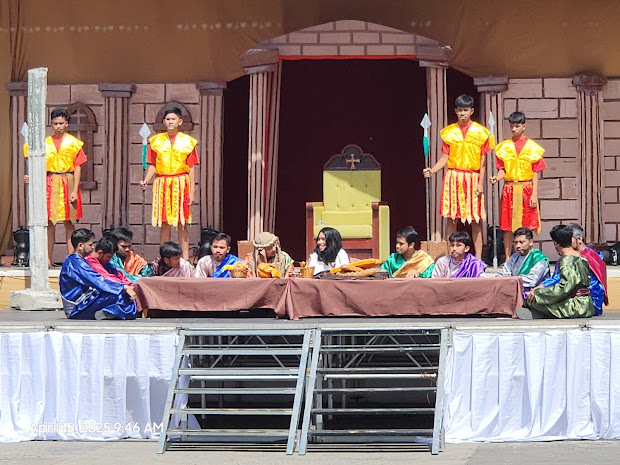Perhaps Good Friday is the most solemn and somber day of the year for Christians. On this day, we commemorate the Crucifixion and Death of Jesus Christ. In the Philippines, we have our own tradition of Senákulo, dramatizing the events of the Passion using traditional scripts. Siete Palabras is a three-hour service reflecting on the Seven Last Words of Jesus. Finally, the Liturgy of the Lord's Passion starts at 3:00 p.m. In the evening some parishes conduct a procession, which culminates in the Rite of Burial.
 |
| The Burial Procession on the evening of Good Friday |
For this year, I traveled a hundred kilometers south of the capital Metro Manila to Ibaan, a small town in the province of Batangas, for our annual Holy Week.
The Archdiocesan Shrine and Parish of St. James the Greater, a Spanish colonial-era church founded in 1832, is the main focus of this blog.
Note: This is a continuation of my 2025 Lenten and Holy Week Pilgrimage from April 13 to 20, 2025. This is the third of four parts; see these links for Part 1, Part 2, and Part 4.
Senákulo: A dramatic play of the Passion of Jesus
Senákulo (from the word 'Cenacle') is a dramatic re-enactment of the events leading up to the Passion, Crucifixion, and Death of Jesus Christ.
Every Good Friday, the youth organization of our parish, Joseph Marello Youth (JMY), hosts the annual passion play in the morning. Our parish does also host a multitude of activities as well during Holy Week and Easter, where they do the Pagdagit and Pagbati traditions on Easter Sunday.
Jericho Fortun Dela Cruz took the role of Jesus in this year's Passion play.
It started at 09:27 with the procession of youth performers on costumes.
After some time, the Twelve Apostles make their way to the outdoor stage, followed by Jesus. He hugs each of his apostles. Soon after, they reenact the Washing of the Feet before the scene of the Last Supper.
 |
| Judas Iscariot being tricked after betraying Jesus |
 |
| Reenactment of Jesus praying at the Garden of Gethsemane |
Not long after, the scene where Judas Iscariot betrays Jesus unfolds. In this play, I saw him being tricked by someone dressed in a black costume. After their conflict, Jesus prayed at the "Garden of Gethsemane". An improvised garden was made for this play. Judas then identifies Jesus to a "soldier" before Jesus was arrested.
 |
| Reenactment of Jesus' trial before the Sanhedrin |
 |
| Jesus (second from left) carries his cross while the soldiers forced him to do so. |
 |
| An emotional Mary cries for Jesus. |
After Jesus was arrested, I saw the scenes of his trial. Commotions were on the rise as the "crowd" wanted Pilate to release Barabbas the Thief. I felt how tense this play was, given the sensitivity of the story. Soon after, I saw Jesus being scourged by soldiers in a brutal sense, especially when he was carrying the Cross (and fell three times). The scene of Jesus with the Women of Jerusalem was reenacted, while when Jesus fell the third time, an emotional Mary (starred by Jhanna Angela Reyes, the same person that starred as Mary during the December 2024 Panunuluyan) cries for Jesus.
 |
| Re-enactment of the Crucifixion at Calvary |
Long story short, we enter the scene of the crucifixion. It depicts the actual crucifixion scene in Calvary: Jesus at the center, flanked by two "criminals". The Seven Last Words were also reenacted. After Jesus dies on the Cross, Mary began to cry out loud that made even those watching beside me cry as well.
 |
| Curtain call of the performers |
The performers then dance to the tune of "Ningas ng Pag-Asa", the Philippine version of the Jubilee 2025 song "Pilgrims of Hope" to wrap up the program at 11:13.
A huge congratulations to Joseph Marello Youth of Ibaan, Batangas, guided under the supervision of its overall director, Mark Justine R. Mendoza!
Afternoon Liturgy and Veneration of the Cross
The Roman Catholic liturgy of Good Friday consists of two parts: the Liturgy of the Word, the Adoration of the Holy Cross, and the Rite of Holy Communion.
The main part of the service was the Adoration of the Cross. A large, veiled crucifix was processed into the altar, pushed by people dressed as the Twelve Apostles. The three veils were removed one by one as the priest chants the first lines of “Sa Kahoy na Krus na Banal”, sang to the tune of the Pasyong Mahal. We then venerated the Cross. The priests venerate it first, followed by the volunteer-apostles, and then, the entire congregation. Lining up is by row, guided by ushers near the center aisle. As per the rubrics, only one crucifix is used for veneration. It took forty-seven minutes for all of us to complete the veneration since it started at 16:54.After the rite of Holy Communion, the liturgy ended at 17:42.
Evening Procession and Rite of Burial
 |
| The Church of Ibaan, Batangas, during the street procession |
A street procession followed along the streets of Ibaan. Thirty (30) carriages of the images of the saints, as well as the Santo Entierro (Holy Burial), were processed in a street procession that was participated by thousands of faithful. During the procession, we prayed the Rosary.
 |
| Burial Rites of the Santo Entierro at the church's Chapel of the Saints |
Later that evening, at 21:00, the Santo Entierro and Mater Dolorosa (Our Lady of Sorrows) were processed one last time, culminating in a burial rite at the Chapel of the Saints (Kapilya ng Mga Santo) within the church complex.
For more updates, visit my blog site and subscribe to my YouTube channel, Enzo's Travel Journals!






Comments
Post a Comment